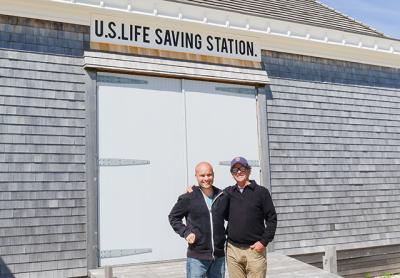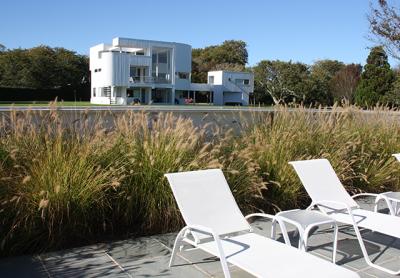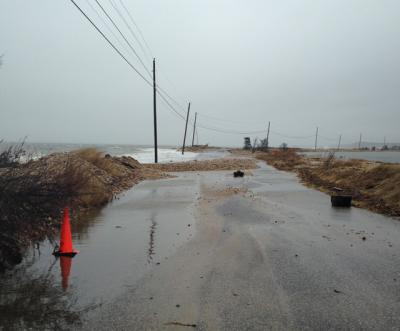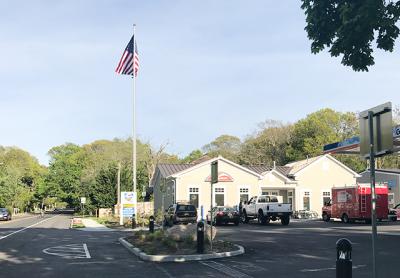It's Time to Get Your 2017 Hamptons Summer Benefit On
It's Time to Get Your 2017 Hamptons Summer Benefit On

The official start of summer might be June 21, but on the East End it comes early — this Saturday, to be exact, when the first of the summer’s benefit events, the ARF Designer Show House, kicks off three months of fund-raisers that support a wide range of charities and cultural institutions. (Click for more details on the ARF event)
Among the other early birds on the benefit calendar is Planned Parenthood Hudson Peconic, whose fund-raiser will take place on Sunday from 5 to 7 p.m. at a private Bridgehampton residence. The event will feature a screening of “Across the Line,” a virtual reality experience that combines drama and documentary to convey the obstacles to accessing abortion in the United States.
A fund-raiser for the Southampton Cultural Center will celebrate six notable East End residents on June 4 from 5 to 8 p.m. at the Southampton Social Club. Food, wines, and silent and live auctions will accompany the honoring of Tom Clavin and Phil Keith, writers; Dan Gasby, a restaurateur; Bonnie Grice, an actress and broadcaster; Paton Miller, an artist, and Mark Epley, Mayor of Southampton Village.
The fact that there are more good causes than summer weekends can create the occasional logjam. While the Madoo Conservancy in Sagaponack has June 16 to itself for its Much Ado About Madoo fund-raiser, at least five big events are scheduled for the following day. School’s Out, the Hetrick-Martin Institute’s benefit for L.G.B.T.Q. youth, will be held at a private residence. Wings Over Haiti, for which 40 artists have donated work to help launch a new school for impoverished children, will take place at the Watermill Center. The Retreat’s All Against Abuse benefit will happen at the Lower Campus of the Ross School. Cocktails on Hook Pond in East Hampton Village will raise funds for the East Hampton Historical Society. The Bridge, a golf course in Bridgehampton, will be the site of Swing Into Summer, a benefit for Group for the East End, an environmental nonprofit that works on the North and South Forks.
Despite the efforts of the Bay Street Theater to celebrate on another day, its benefit will once again share the same night, July 15, with the Parrish Art Museum, as it has done in years past. Both evenings will unfold al fresco, Bay Street’s under a tent on Long Wharf in Sag Harbor, the Parrish’s on its covered terrace in Water Mill.
LongHouse Reserve and the Watermill Center can always be counted on to reach for the heavens. Boom! Our Cosmic Benefit will unfold at LongHouse on July 22 and will honor Alexandra Munroe, curator of the Guggenheim’s forthcoming exhibition “Art and China After 1989,” and the Chinese artist Cai Guo-Qiang, who will have exhibitions in the fall at the Pushkin Museum in Moscow and the Prado in Madrid.
The Watermill Center inevitably draws notables from the worlds of art, performance, theater, fashion, and design. This year’s benefit, Fly Into the Sun, will honor Laurie Anderson, Isabelle Huppert, and the late Lou Reed on July 29. Widely considered the most imaginative of the summer’s events, it will include installations and performances throughout the center’s eight-and-a-half acres.
In August, as the summer begins to wind down, fund-raisers will be held for the Breast Cancer Research Foundation, Southampton Hospital, Peconic Land Trust, Guild Hall, the East Hampton Library, and East End Hospice.
A more comprehensive schedule of the summer’s benefits with times and starting ticket prices follows below.
• May 26, Garden Club of East Hampton Party and Plant Sale, Mulford Farm, East Hampton, 6-8 P.M., $50, gceasthampton.org
• May 27, Animal Rescue Fund Designer Showhouse, ARF Thrift and Treasure Shop, 17 Montauk Highway, Sagaponack, 6-8 P.M., $150 Preview 5-6 p.m. $250, arfhamptons.org
• May 27, LGBT Network Backyard BBQ, Southampton, 2-6 p.m., $90; LGBT Summer Kick-Off Reception, Bridgehampton Tennis and Surf Club, 6-8 p.m. $325, lgbtnetwork.org
• May 28, Planned Parenthood Hudson Peconic, private residence, Bridgehampton, 5-7 p.m. $200, plannedparenthood.org
• June 3, Eleanor Whitmore Early Childhood Center, barn dance at Kilmore Farm, Wainscott, 6:30 p.m. $200, ewecc.org
• June 3, Fighting Chance Gala, Maidstone Club, East Hampton, 6-11 p.m. $450, fightingchance.org
• June 3, Southampton Fresh Air Home: Decorators, Designers, and Dealers Sale and Auction, Barkers Island Road, Southampton, 5-8:30 p.m., $250, sfah.org
• June 4, Southampton Cultural Center, Evening of Wine and Roses, Southampton Social Club, 256 Elm Street, Southampton, 5-8 p.m. $225, scc-arts.org
• June 10, God’s Love We Deliver, Midsummer Night Drinks, Calvin Klein residence, Meadow Lane, Southampton, 6-9 p.m. $500, glwd.org
• June 10, American Heart Association, Hamptons Heart Ball, Southampton Arts Center, 6-11 p.m., $600, www.heart.org
• June 10 & 11, Parrish Art Museum, Landscape Pleasures, symposium and garden tour, museum and various locations, $225, parrishart.org
• June 16, Madoo Conservancy, Much Ado about Madoo preview Garden Cocktail Party, 6:30-8:30 p.m. $200, $150 members, madoo.org
• June 17, Group for the East End, Swing Into Summer, The Bridge, Bridgehampton, 6:30-11:30 p.m. , $1,000, groupfortheeastend.org
• June 17, Animal Rescue Fund of the Hamptons, Garden Tour of East Hampton Village, 11 a.m.-5 p.m., $85; cocktails the night before, $175, arfhamptons.org
• June 17, East Hampton Historical Society, Cocktails at Hook Pond, Dorian and Gary Fuhrman residence, East Hampton, 6-8 p.m. $150, easthamptonhistory.org
• June 17, Hamptons Artists for Haiti, Watermill Center, Water Mill, 5:30-8:30 p.m., $125, wingsoverhaiti.net
• June 17, Hetrick-Martin Institute, School's Out dinner, Lisa and James Cohen residence, East Hampton, $375 cocktails, $1,500 dinner, hmi.org
• June 17, Navy Seal Foundation, cocktail party, Navy Beach restaurant, Montauk, 3-5 p.m., $50; $25 veterans, navybeach.com
• June 17, The Retreat, All Against Abuse Gala: A Night in Havana, Ross School Lower Campus Field House, Bridgehampton, 6:30 p.m. $500, theretreatinc.org
• June 17, Sag Harbor Historical Society, annual benefit party, Breakwater Yacht Club, Sag Harbor, 6 p.m. $100, sagharborhistorical.org
• June 22, Camp Soulgrow, annual benefit dinner, The Palm restaurant, East Hampton, 6-8 p.m., $60, campsoulgrow.org
• June 24, Wellness Foundation, Mulford Farm, East Hampton, 6-8 p.m. $175, wfeh.org
• June 24, East End Hospice, An Evening in Paris, Jeffery residence, Second Neck Lane, Quogue, 7-11 p.m. $275, eeh.org
• June 24, Nature Conservancy on Long Island, a Benefit for Clean Water on Long Island, Center for Conservation, East Hampton, 7 p.m., $1,000. nature.org
• June 24, Stony Hill Stables Foundation, Back in the Saddle cocktail party, Stony Hill Stables, Amagansett, 6-8 p.m., $125, stonyhillstables.com
• June 25, Bridgehampton Child Care and Recreational Center, Jazz for Jennings, Watermill Center, 12:30-4 p.m. $500, www.bhccrc.org
• June 30, Southampton Fresh Air Home, American Picnic and Grucci Fireworks, 1030 Meadow Lane, Southampton, 7 p.m., $300, sfah.org
• July 1, Cormaria, Summer Gala, Cormaria Retreat House, Sag Harbor, 7 p.m., $250, cormaria.org
• July 1, Guild Hall, Season Spectacular performance with Jay Leno and dinner at a private location, East Hampton, $1,000, guildhall.org
p.p1 {margin: 0.0px 0.0px 0.0px 0.0px; font: 11.0px Helvetica; -webkit-text-stroke: #000000}
span.s1 {font-kerning: none}
• July 8, South Fork Natural History Museum Summer Gala, South Fork Natural History Museum and Nature Center, 377 Bridgehampton-Sag Harbor Turnpike, Bridgehampton, 6-10 p.m. $425, sofo.org
• July 8, Southampton Animal Shelter Foundation, Unconditional Love Gala, Gin Lane, Southampton, 6:30 p.m., $1,000, southamptonanimalshelter.com
• July 8, Southampton Historical Museum, Halsey House Gala: Sur la Plage, Thomas Halsey Homestead, 249 South Main Street, Southampton, 5:30-8 p.m., $300, southamptonhistoricalmuseum.org
• July 8, Population Earth, Ribs for Kids barbeque competition, 1610 Meadow Lane, 6-11 p.m., $400 in advance, $500 at the door. Chefscarebbq.com
• July 15, Parrish Art Museum Midsummer Party, Montauk Highway, Water Mill, 6:30-1 a.m. $1,500, parrishart.org
p.p1 {margin: 0.0px 0.0px 0.0px 0.0px; font: 11.0px Helvetica; -webkit-text-stroke: #000000}
span.s1 {font-kerning: none}
• July 15, Bay Street Theater Annual Summer Gala, Long Wharf, Sag Harbor, 6-10 p.m., $1,500, baystreet.org
• July 15, St. Jude Children's Hospital, Hope in the Hamptons, Deerfield Road, Water Mill, 6 p.m., $250; $300 after June 15, stjude.org
• July 15, Hamptons Tea Dance, presented by The Center, Services and Advocacy for G.L.B.T. Elders, and Callen-Lorde Community Health Center, Nova's Ark Project, Bridgehampton, 4-8 p.m., $300, hamptonsteadance.org
p.p1 {margin: 0.0px 0.0px 0.0px 0.0px; font: 11.0px Helvetica; -webkit-text-stroke: #000000}
span.s1 {font-kerning: none}
• July 15, Rush Philanthropic Arts Foundation, Art for Life Benefit, Fairview Farms, 19 Horsemill Lane, Bridgehampton, 6 p.m.,$1,500, artforlife.rushphilanthropic.org
• July 21, East Hampton Historical Society, preview cocktail party for annual East Hampton Antiques Show, Mulford Farm, East Hampton, 6-8:30 p.m. $150, easthamptonhistory.org
• July 22, Children's Museum of the East End, Family Fair Fundraiser: Animals A to Z, Bridgehampton, 10:30 a.m.-1:30 p.m., $200 adults, $150 childen with discounts for advanced purchases, cmee.org
• July 22, LGBT Network, Sunset on the Harbor, Breakwater Yacht Club, Sag Harbor, 5-8 p.m., $175, lgbtnetwork.org
• July 22, LongHouse Reserve, Boom! The Cosmic LongHouse Benefit, 133 Hands Creek Road, East Hampton, 6-11 p.m. $1,250, longhouse.org
• July 22, Shelter Island Historical Society, Black and White benefit, Havens Barn, 16 South Ferry Road, Shelter Island, 6-10 p.m. $231, shelterislandhistorical.org
• July 27, Maureen's Haven, Lobster Bash, Docker's Restaurant, 94 Dune Road East Quogue, 6:30-10:30 p.m. $200, maureenshaven.com
• July 28, Perlman Music Program Annual Summer Benefit, P.M.P. campus, Shelter Island, 6 p.m., $350 cocktails, $1,000 dinner, perlmanmusicprogram.org
p.p1 {margin: 0.0px 0.0px 0.0px 0.0px; font: 11.0px Helvetica; -webkit-text-stroke: #000000}
span.s1 {font-kerning: none}
• July 28-30, Bridgehampton Benefit for multiple non-profits, The Children Matter, location to be announced, $1,000, bridgehamptonbenefit.com
• July 29, All Star Code Summer Benefit, Lewis residence, Lily Pond Lane, East Hampton, $1,000, allstarcodebenefit.org
• July 29, James Beard Foundation, Chefs and Champagne, Wolffer Estate Vineyard, Sagaponack, 6 p.m., $275, jamesbeard.org
• July 29, Watermill Center, Fly into the Sun benefit and auction, Watermill Center, 39 Water Mill Towd Road, Water Mill, $500 cocktails, $1,500 dinner, watermillcenter.org
• July 29, OCRFA Super Saturday, Nova’s Ark Project, Bridgehampton, noon-6 p.m., $450, ocrfa.org/events/super-saturday/
p.p1 {margin: 0.0px 0.0px 0.0px 0.0px; font: 11.0px Helvetica; -webkit-text-stroke: #000000}
span.s1 {font-kerning: none}
• July 30, Hayground School Chefs Dinner, Hayground School, 151 Mitchell Lane, Bridgehampton, 5 p.m., $1,200, haygroundchefsdinner.org
• July 31, Comedy for a Cause to benefit The Juvenile Diabetes Foundation, Topping Rose House, One Bridgehampton-Sag Harbor Turnpike, Bridgehampton, 7 p.m. $185, feliciamadison.com
• Aug. 3, UJA Federation of New York, Hamptons Trunk Show, Bridgehampton Historical Society, 10 a.m.-4 p.m., $36, rain or shine, ujafedny.org
p.p1 {margin: 0.0px 0.0px 0.0px 0.0px; font: 11.0px Helvetica; -webkit-text-stroke: #000000}
span.s1 {font-kerning: none}
• Aug. 5, Breast Cancer Research Foundation, Hamptons Paddle for Pink, Havens Beach, Sag Harbor, 8 a.m., Hamptons Party for the Pink, private residence, Sag Harbor, 7 p.m., $1,500, bcrfcure.org
• Aug. 5, Southampton Hospital Summer Party, Wickapogue Road and Old Town Road, Southampton, 6:30 p.m., $500, southamptonhospital.org
p.p1 {margin: 0.0px 0.0px 0.0px 0.0px; font: 11.0px Helvetica; -webkit-text-stroke: #000000}
li.li1 {margin: 0.0px 0.0px 0.0px 0.0px; font: 11.0px Helvetica; -webkit-text-stroke: #000000}
span.s1 {font-kerning: none}
span.s2 {font: 12.0px Helvetica}
span.s3 {text-decoration: underline ; font-kerning: none}
• Aug. 5, Bridgehampton Chamber Music Festival, Get in the Groove, Atlantic Golf Club, Bridgehampton, 6:30 p.m., $1,500, bcmf.org
• Aug. 5, Montauk Playhouse, the Playhouse Gala, Montauk Playhouse, Edgemere Street, Montauk, 7-11 p.m., $300, montaukplayhouse.org
• Aug. 5, Thomas Moran Trust Garden Party, The Thomas and Mary Nimmo Moran Studio, Main Street, East Hampton, 6-8 p.m., $150, thomasmorantrust.org
• Aug. 5, The Samuel Waxman Cancer Research Foundation, A Hamptons Happening, Maria and Kenneth Fishel residence, Bridgehampton, 6:30-8:30 p.m. $425, waxmancancer.org
p.p1 {margin: 0.0px 0.0px 0.0px 0.0px; font: 15.0px Calibri; -webkit-text-stroke: #000000}
span.s1 {font-kerning: none}
• Aug. 6, Peconic Land Trust, Through Farms and Fields, White Cap Farm, Water Mill, 4 p.m., $350, peconiclandtrust.org
• Aug. 10, Ellen Hermanson Foundation, Evening of Enchantment, Topping-Rose House, Bridgehampton, 6:30-10 p.m. $500, ellenhermanson.org
• Aug. 11, Guild Hall Summer Gala, Guild Hall and private residence, East Hampton, 5-11 p.m., $500 cocktails, $1,250 dinner, guildhall.org
• Aug. 11, Veterinarians International, Trunks of Love Gala, DOPO La Spiaggia, East Hampton, 6-10 p.m., $150, veterinariansinternational.org
• Aug.12, East Hampton Library, Authors Night, Field at 4 Maidstone Lane and private residences, East Hampton, 5-10 p.m., $100 reception, $300 dinner, easthamptonlibrary.org
• Aug. 12, Wildlife Center of the Hamptons, Get Wild!, Leslie Alexander and Liz Brown residence, Southampton, 6-8 p.m., $225, wildliferescuecenter.org
• Aug. 19, Animal Rescue Fund, Bow Wow Meow Ball, ARF Adoption Center, 91 Daniels Hole Road, Wainscott, 6:30 p.m., $500, arfhamptons.org
• Aug. 26, East End Hospice, Box Art Auction, featuring 90 artists' interpretations of a cigar box, St. Luke's Hoie Hall, 4:30-7 p.m. Free preview reception Aug. 23-24, 4:30-8 p.m., eeh.org
• Aug. 31, Southampton Arts Center, Summerfest, 25 Jobs Lane, 6-10 p.m. southamptonartscenter.org
p.p1 {margin: 0.0px 0.0px 0.0px 0.0px; font: 11.0px Helvetica; -webkit-text-stroke: #000000}
p.p2 {margin: 0.0px 0.0px 0.0px 0.0px; font: 11.0px Helvetica; -webkit-text-stroke: #000000; min-height: 13.0px}
li.li1 {margin: 0.0px 0.0px 0.0px 0.0px; font: 11.0px Helvetica; -webkit-text-stroke: #000000}
span.s1 {font-kerning: none}
span.s2 {font: 12.0px Helvetica}
span.s3 {text-decoration: underline ; font-kerning: none}









